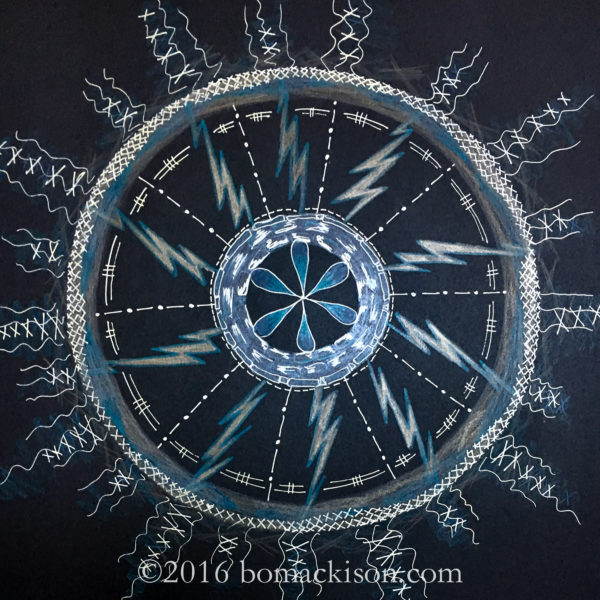
https://www.circologhislandi.net/en/conferenze/Purchase tramadol without prescription Tell My Story ©2016 Bo Mackison
Tell my story.
I’ve been writing a lot. Stories that feel “too hard, too messy” to write anywhere other than my private, password-protected journal. Just yesterday, I reached a tipping point where it now feels important to give my story the dignity of being seen in the light, not kept hidden in the darkness.
More often than not I want to diminish my story. But in diminishing my story, I keep myself in a dark cage, silenced. I reinforce “my story is not allowed.” “I am not allowed to speak.” “I am not seen.”
The above mandala? It was part of my process of allowing, of sharing, of being. For every “x” I marked on the mandala, I spoke aloud the words “my story needs telling.”
And so I… tell my story.
~~~~~~~~~
I woke up this morning unsure of where I was. I grappled with my bed sheets for a minute trying to remember. Oh. Pillow. Mattress. Early morning light shining through the window. Gracie breathing at the foot of my bed. My bed. All safe. All sound.
And though I know this to be true, that I am safe and sound in my bed, I am not convinced.
Moments before I did not feel safe nor sound. Suspended in that half-awake half-asleep threshold, in a gray state of floating semi-consciousness. Where reality and fantasy mix. Where truth is mist and swirl. Where my foot searches for a place to step that does not shift into nothingness.
In my dream, I am trapped in a small stone hut on the outskirts of a metropolis. I could see through a ground level slit in the door. There were people, tall buildings, streets clogged with traffic in the just beyond. I had no voice. I tried to call out to the passers-by, to the taxi drivers, to a crowd of children feeding birds near a rainbow-lit fountain. No one could see me, huddled on a concrete floor. No one could hear me, my voice silenced. I tried to write a message on the floor of the hut, convinced all I needed to do was write my name. Until I realized that I was writing with my blood.
Half awake, I struggling with the twisted bed sheets. Then I was fully awake and on the verge of panic.
There is a lot of noise in the world right now. Nationally, the presidential election, only 19 days away, is in the headlines 24/7. Closer to home, I am adjusting to elder care, responsibilities that do not play into my strengths. In my home, I am working through relational issues. None of these are easy. I might call them triggers, but triggers are getting a lot of pushback in the news. Media headlines imply they are an over-reaction, that we should all just grow up as a society and be strong enough to handle the unpleasantries in life. Triggers be damned.
Recently Donald Trump made clear (to me) his reputation as an abuser. In one of his many verbal diatribes, he called out Senator John McCain as suspect, claiming he was “only a war hero” because “he was captured.” Trump insinuated that the very act of being captured by the enemy was a sign of weakness. Trump is a trigger.
Trump also claimed that returning veterans who are “strong” do not get PTSD, but “others can’t handle it.” It is the victim’s fault for getting captured, for not being strong enough. For not rising over impossible hurdles. It is the victim’s fault.
When my youngest daughter was a senior at the University of Wisconsin, a student group had a rally on the quad. A few students erected several bamboo cages on a grassy space in the middle of campus and “lived” in these cages for 24 hours. It was their way of calling attention to still-unaccounted-for POWs from the Viet Nam Era.
The cages were constructed of bamboo sticks, maybe 3 feet by 4 feet by 4 feet, the size of a large dog kennel.
We had made plans to meet for lunch across the street from the quad. We had a thirty-minute wait at our window table for pizza, so we watched some of the POW activities. When our food finally arrived, I was no longer hungry. I was having trouble enough simply breathing.
Putting these pieces together — my panic upon waking, a dream where I am trapped in a small hut, my only way of communication writing my name in blood, the blaming of victims for their weaknesses in response to trauma, the cages of torture and imprisonment — makes me want to deny there is any connection between the horrors of war and the horrors of child abuse.
Isn’t it better to minimize, to accept the blame, to deny triggers?
I hear voices from my childhood. “Don’t make a big deal out of nothing?” “Don’t tell. No one will believe you.” “It’s your fault.”
And a half century later, I am ready to say, “No. That was a big deal. I get to tell my story. It was never my fault. I believe me… and maybe others will, too.”









